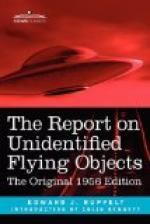When the panel’s conclusions were made known in the government, they met with mixed reactions. Some people were satisfied, but others weren’t. Even the opinions of a group of the country’s top scientists couldn’t overcome the controversy that had dogged the UFO for five years. Some of those who didn’t like the decision had sat in on the UFO’s trial as spectators and they felt that the “jury” was definitely prejudiced— afraid to stick their necks out. They could see no reason to continue to assume that the UFO’s weren’t interplanetary vehicles.
CHAPTER SEVENTEEN
What Are UFO’s?
While the scientists were in Washington, D.C., pondering over the UFO, the UFO’s weren’t just sitting idly by waiting to find out what they were—they were out doing a little “lobbying” for the cause— keeping the interest stirred up.
And they were doing a good job, too.
It was just a few minutes before midnight on January 28, 1953, when a message flashed into Wright-Patterson for Project Blue Book. It was sent “Operational Immediate,” so it had priority handling; I was reading it by 12:30A.M. A pilot had chased a UFO.
The report didn’t have many details but it did sound good. It gave the pilot’s name and said that he could be reached at Moody AFB. I put in a long-distance call, found the pilot, and flipped on my recorder so that I could get his story word for word.
He told me that he had been flying an F-86 on a “round-robin” navigation flight from Moody AFB to Lawson AFB to Robins AFB, then back to Moody—all in Georgia. At exactly nine thirty-five he was at 6,000 feet, heading toward Lawson AFB on the first leg of his flight. He remembered that he had just looked down and had seen the lights of Albany, Georgia; then he’d looked up again and seen this bright white light at “ten o’clock high.” It was an unusually bright light, and he said that he thought this was why it was so noticeable among the stars. He flew on for a few minutes watching it as he passed over Albany. He decided that it must be an extremely bright star or another airplane—except it just didn’t look right. It had too much of a definitely circular shape.
It was a nice night to fly and he had to get in so much time anyway, so he thought he’d try to get a little closer to it. If it was an airplane, chances were he could close in and if it was a star, he should be able to climb up to 30,000 feet and the light shouldn’t change its relative position. He checked his oxygen supply, increased the r.p.m. of the engine, and started to climb. In three or four minutes it was obvious that he was getting above the light, and he watched it; it had moved in relation to the stars. It must be an airplane then, he’d decided—an airplane so far away that he couldn’t see its red and green wing tip lights.




